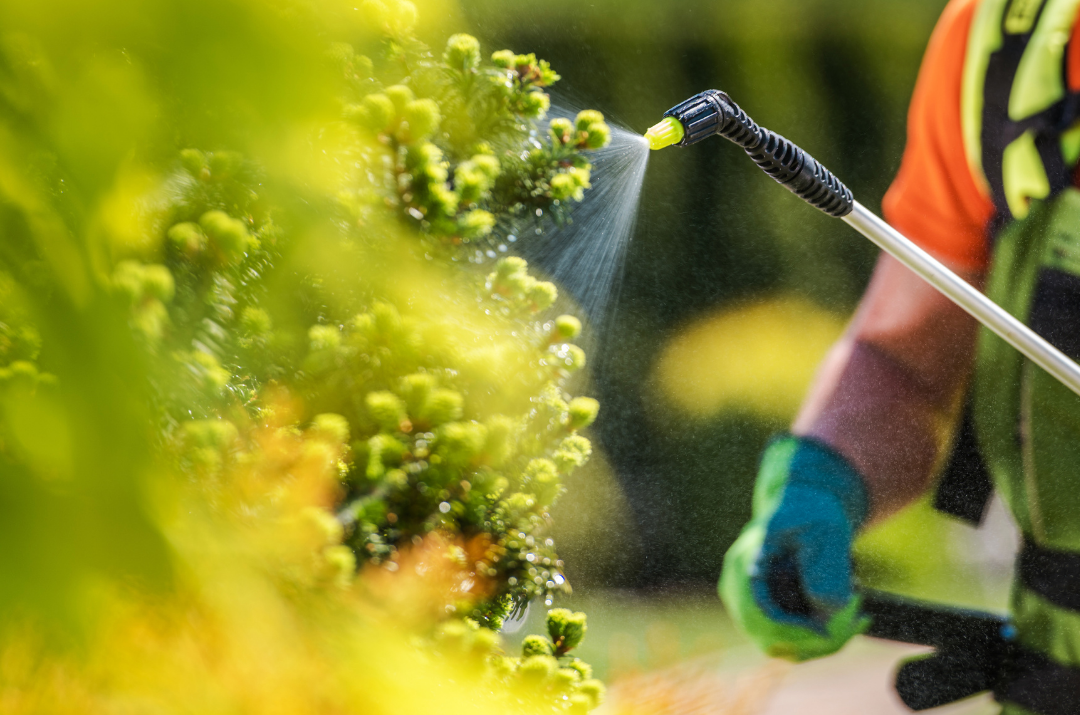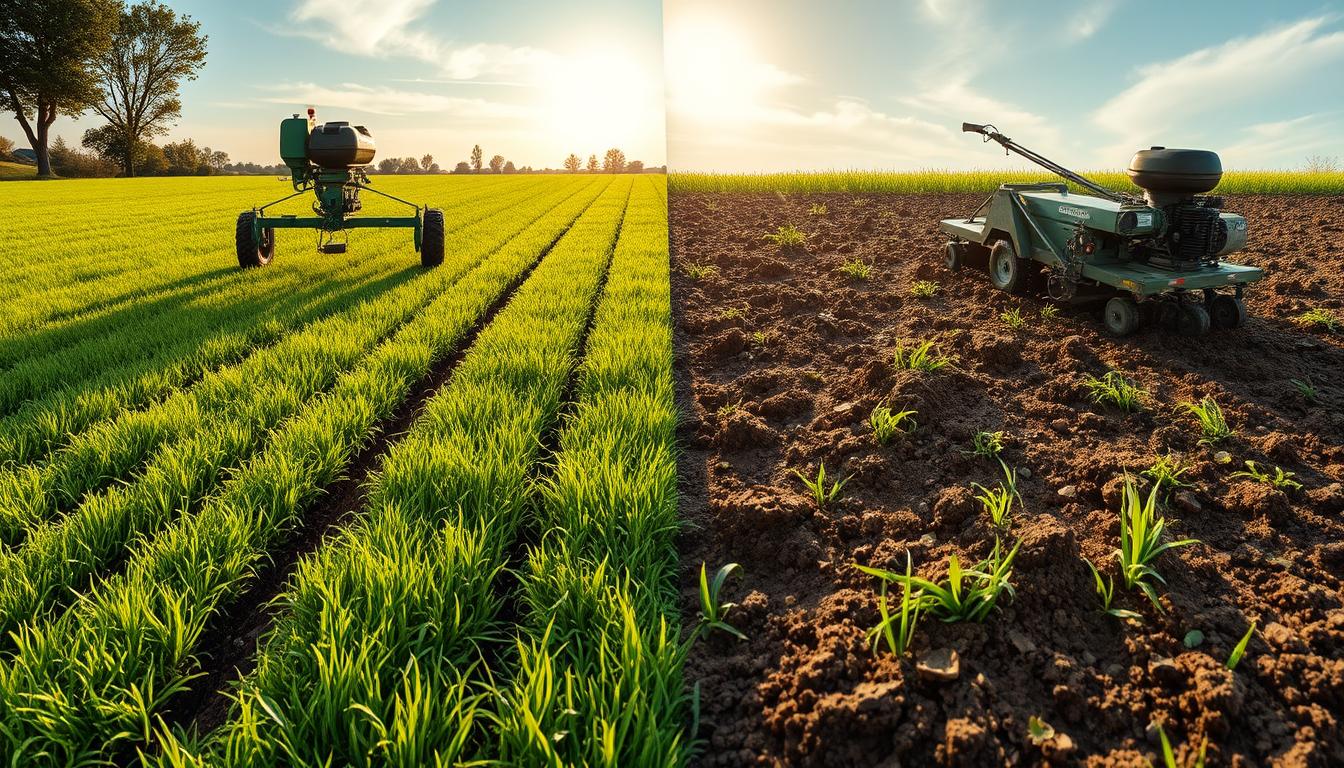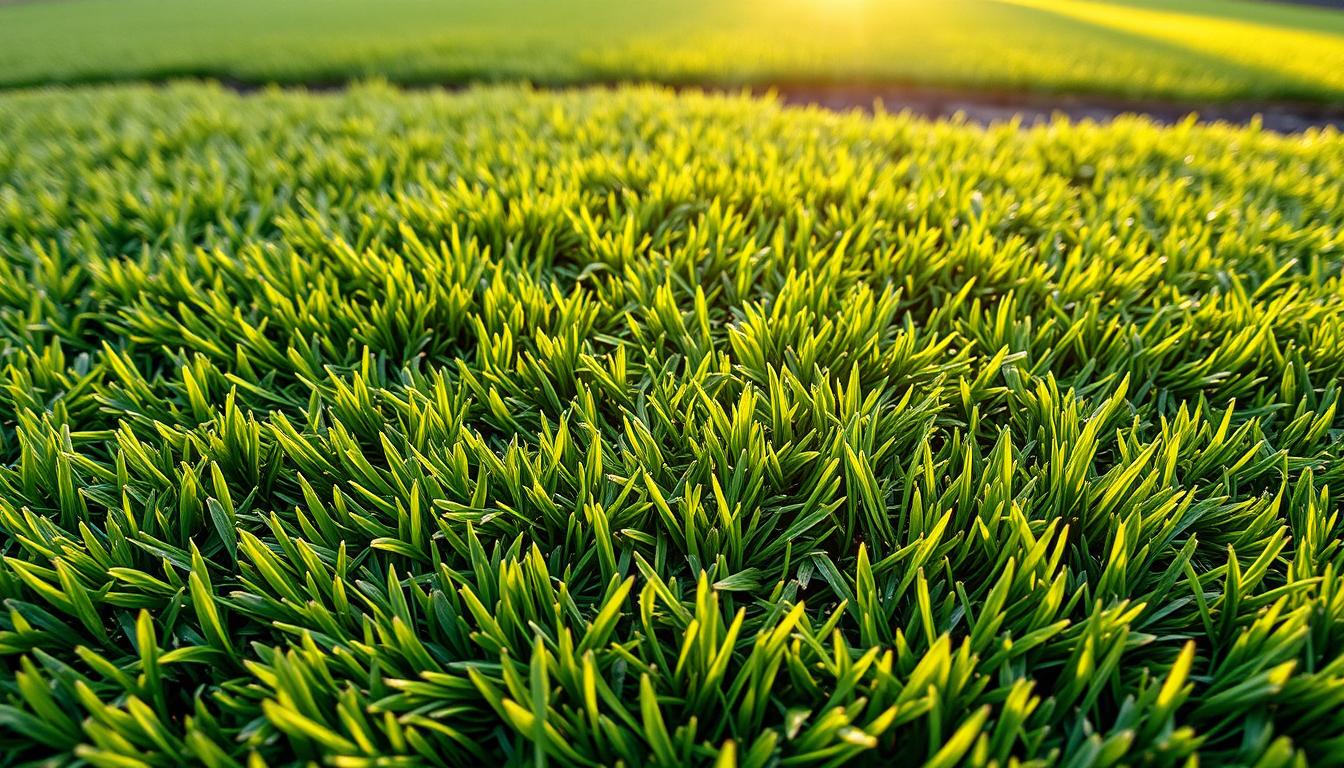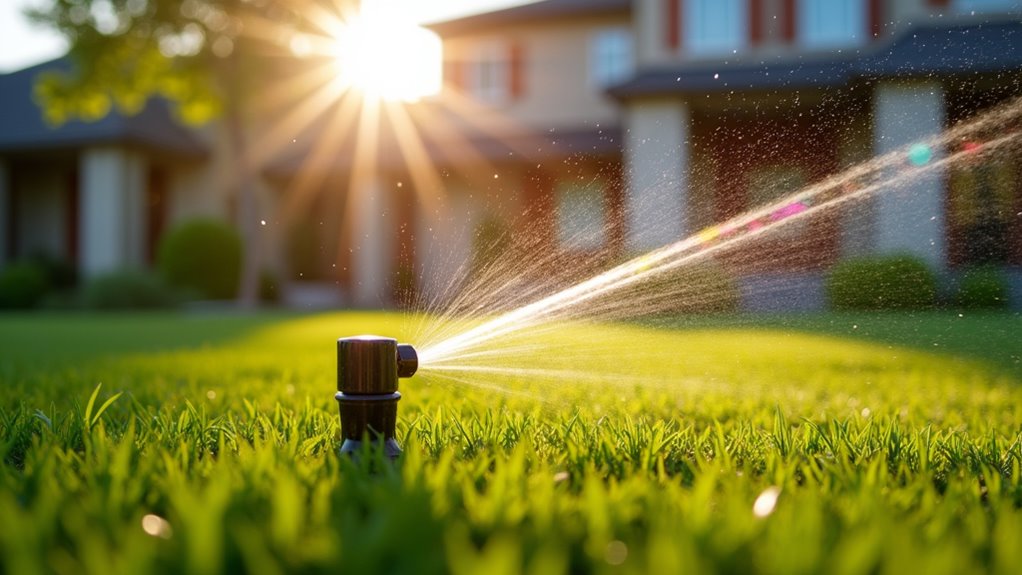Modern irrigation systems now combine AI-powered controls with precision drip technology to enhance your farm’s water efficiency. You’ll find smart controllers that automatically adjust water flow based on real-time soil moisture data and weather conditions, achieving up to 95% efficiency. For small farms, sustainable drip systems cost $2,500-$5,000 per acre, while large operations benefit from automated center pivot systems with GPS tracking. The latest innovations in agricultural water management will transform how you approach crop irrigation.
Understanding Modern Irrigation Technologies

Modern irrigation technologies have revolutionized agricultural water management through precision control systems and data-driven solutions. You’ll find that drip irrigation systems now deliver water directly to plant roots, maximizing moisture retention while reducing waste. Pivot technology enables you to cover large areas efficiently, adapting water distribution based on specific field conditions.
To enhance your crop yield, you’ll need to implement smart irrigation scheduling that responds to real-time soil health indicators. These systems monitor moisture levels, weather patterns, and crop requirements, automatically adjusting water delivery. You’re able to achieve up to 95% water efficiency through automation benefits that eliminate human error and guarantee consistent irrigation timing. The technology also helps maintain ideal soil health by preventing over-saturation and nutrient leaching, making your farming operation more sustainable and productive.
Smart Drip Systems: Precision Water Management

While traditional irrigation methods often waste significant water through evaporation and runoff, smart drip systems deliver precise amounts of water directly to your crops’ root zones. These modern drip irrigation solutions integrate sensors, automation, and real-time monitoring to enhance water efficiency and crop yields.
- Smart controllers adjust water flow based on soil moisture, weather conditions, and crop-specific needs
- Pressure-compensating emitters guarantee uniform water distribution across your entire field
- Mobile apps let you monitor and control your system remotely, saving time and labor
- Advanced filtration systems prevent clogging and extend system longevity
You’ll achieve up to 95% water efficiency compared to conventional methods, making smart drip systems an excellent investment for your farm’s sustainability and profitability. These systems pay for themselves through reduced water consumption and increased crop productivity.
Center Pivot Systems and AI Integration
Your center pivot system’s integration with AI technology improves water efficiency through real-time soil moisture analysis and predictive weather modeling. You’ll gain precise control over irrigation schedules by connecting remote monitoring systems to your smart device, allowing instant adjustments based on field conditions. The AI’s machine learning algorithms optimize water distribution patterns across your circular coverage area while automatically documenting usage data for compliance and resource management.
AI-Powered Water Management
Recent advances in artificial intelligence have revolutionized center pivot irrigation systems, allowing farmers to achieve unprecedented water efficiency through smart automation. AI irrigation platforms now integrate real-time data from soil moisture sensors, weather stations, and satellite imagery to optimize water distribution across your fields.
- Machine learning algorithms predict crop water needs based on growth stages and environmental conditions
- Smart sensors detect soil moisture levels at diverse depths, preventing over-irrigation and water waste
- Automated scheduling adjusts water application rates according to weather forecasts and evapotranspiration data
- Water optimization software creates detailed irrigation maps, ensuring precise coverage for different crop zones
You’ll find these AI-powered systems can reduce water consumption by up to 30% while maintaining or improving crop yields. The technology continuously learns from your field’s data, becoming more efficient with each growing season.
Remote Monitoring and Control
Modern remote monitoring systems transform how you manage center pivot irrigation through seamless integration with mobile devices and AI platforms. You’ll receive real-time system alerts about weather conditions, soil moisture levels, and equipment status directly on your smartphone. Remote access enables instant adjustments to water application rates and pivot speed from anywhere.
| Feature | Benefit |
|---|---|
| GPS Tracking | Precise pivot positioning and movement monitoring |
| Weather Integration | Automated scheduling based on forecast data |
| Equipment Diagnostics | Preventive maintenance and fault detection |
| Resource Analytics | Water usage optimization and efficiency reports |
These monitoring capabilities reduce operational costs while maximizing irrigation efficiency. By leveraging cloud-based dashboards, you can analyze historical performance data and implement data-driven improvements to your irrigation strategy. The system’s predictive maintenance features help prevent costly downtime and guarantee consistent crop coverage throughout your growing season.
Sustainable Solutions for Small-Scale Farms
While large industrial farms often rely on extensive irrigation infrastructure, small-scale farmers can implement highly effective and sustainable water management solutions that minimize environmental impact while maximizing crop yields. You’ll find that integrating sustainable practices with organic methods creates a strong system that’s both environmentally responsible and economically viable.
Small-scale farming proves that sustainable water management can achieve both environmental stewardship and profitable crop production without industrial-scale infrastructure.
- Combine permaculture techniques with water efficient crops to reduce irrigation needs while maintaining soil health
- Implement crop rotation strategies that optimize water usage and improve natural soil fertility
- Use eco-friendly fertilizers derived from local resources to enhance water retention
- Engage with your community to share sustainable irrigation knowledge and pool resources
Large-Scale Agricultural Water Management
You’ll find center pivot irrigation systems optimize coverage efficiency while reducing labor costs across expansive field operations. Your drip system network requires strategic planning of mainlines, sub-mains, and laterals to guarantee uniform water distribution and pressure regulation throughout large agricultural plots. Smart water monitoring technologies let you track soil moisture levels, weather patterns, and crop water demands in real-time, enabling precise irrigation scheduling across your entire operation.
Center Pivot Irrigation Benefits
Center pivot irrigation systems deliver exceptional water-use efficiency across expansive agricultural operations, making them a cornerstone of large-scale farming. You’ll achieve significant efficiency improvement through precise water distribution and automated controls, maximizing your crop yield while minimizing resource waste.
- Uniform water coverage across circular fields up to 500 acres, ensuring consistent crop development
- Remote monitoring and control capabilities let you adjust irrigation patterns based on real-time weather conditions
- Reduced labor costs compared to traditional irrigation methods, with one operator managing multiple systems
- Energy-efficient operation through low-pressure sprinklers and variable-rate technology
When you implement center pivot systems, you’ll gain the ability to manage water resources strategically while maintaining ideal soil moisture levels. This precision approach supports sustainable farming practices and helps you meet increasing production demands.
Drip System Network Design
When designing a large-scale drip irrigation network, careful planning of mainlines, submains, and lateral lines becomes essential for ideal water distribution across your agricultural operation. You’ll need to map your field’s topography and soil variations to optimize the network layout and guarantee uniform water delivery.
Position your mainlines along field boundaries or access roads, with submains branching perpendicular to the slope. Space your lateral lines according to crop type and row spacing, typically 12-48 inches apart. Install pressure regulators at key junction points to maintain consistent flow throughout the system.
One of the key drip system benefits is its adaptability to irregular field shapes. You can adjust emitter spacing and flow rates to match specific crop water requirements while maintaining system efficiency through zone-based management and automated controls.
Smart Water Monitoring Solutions
Modern smart water monitoring solutions revolutionize large-scale irrigation management through integrated sensor networks and real-time data analytics. You’ll enhance water efficiency by implementing smart irrigation controllers that automatically adjust watering schedules based on soil moisture levels, weather conditions, and crop requirements.
- IoT-enabled moisture sensors provide instant feedback on soil conditions, helping you prevent over-watering and under-watering
- Mobile applications give you remote control and monitoring capabilities, allowing real-time adjustments from anywhere
- Automated flow meters detect leaks and equipment malfunctions, reducing water waste and system downtime
- AI-powered analytics platforms predict irrigation needs based on historical data and weather forecasts
These technologies empower you to make data-driven decisions, improve resource allocation, and achieve sustainable water management practices while maintaining peak crop yields.
Cost Analysis and Return on Investment
Investing in an irrigation system requires careful financial analysis to determine both immediate costs and long-term benefits. You’ll need to evaluate the cost breakdown of essential components, including pipes, pumps, controllers, and installation labor. For a small farm of 10 acres, expect initial investments between $2,500-$5,000 per acre, while larger operations may gain from economies of scale.
Your investment timeline should account for maintenance costs, energy consumption, and potential water savings. Modern systems typically pay for themselves within 2-5 years through reduced labor costs and increased crop yields. You’ll save 20-30% on water usage compared to traditional methods, while precision application can enhance yields by 15-25%. Evaluate government incentives and agricultural grants that may offset your initial investment.
Weather-Based Irrigation Controls
Modern weather-based irrigation controls integrate specialized sensors that monitor humidity, temperature, rainfall, and wind conditions to enhance your farm’s water usage. You’ll find that real-time weather data features sync with local meteorological stations and satellite feeds, enabling precise adjustments to irrigation schedules based on current and forecasted conditions. Your automated soil moisture control systems can respond intelligently to these weather inputs, maintaining ideal soil saturation levels while preventing both under-watering and water waste through dynamic flow regulation.
Smart Sensor Integration Methods
Advanced weather-based irrigation controls are revolutionizing farm water management through the integration of smart sensors. With sensor technology advancements, you’ll achieve precise water distribution by connecting soil moisture probes, weather stations, and flow meters to your central control system. Data-driven irrigation decisions now rely on real-time analytics, ensuring ideal crop hydration while conserving resources.
- Install wireless soil moisture sensors at multiple depths to monitor root zone conditions
- Connect automated weather stations to track rainfall, humidity, and evapotranspiration rates
- Integrate flow meters to measure water usage and detect system irregularities
- Implement sensor nodes with cellular or LoRaWAN connectivity for remote monitoring
Your smart sensor network will continuously gather field data, enabling automated adjustments to irrigation schedules based on actual crop needs rather than predetermined timelines.
Real-Time Weather Data Features
While traditional irrigation systems rely on fixed schedules, real-time weather data integration lets you dynamically adjust water delivery based on current and forecasted conditions. You’ll optimize water usage by accessing satellite data, local weather stations, and atmospheric sensors that monitor precipitation, humidity, and evapotranspiration rates.
Your system’s climate adaptation capabilities will automatically adjust irrigation patterns when detecting incoming weather events. Through real-time forecasting algorithms, you can anticipate rainfall 24-72 hours in advance, allowing for precise irrigation scheduling. The system analyzes historical weather patterns alongside current data to make informed decisions about water distribution across your fields.
You’ll receive instant alerts about extreme weather conditions, enabling quick responses to protect crops while conserving water resources during critical growing periods.
Automated Soil Moisture Control
Smart soil moisture control systems integrate real-time weather data with underground sensor networks to maintain ideal soil hydration levels. You’ll enhance water efficiency while preventing both over-saturation and drought stress through automated irrigation that responds to your soil’s actual needs.
- Wireless moisture sensors placed at multiple soil depths transmit continuous hydration data to your central control system
- AI-driven controllers automatically adjust irrigation schedules based on sensor readings and weather forecasts
- Precision zoning allows for different watering parameters across diverse crop types and soil conditions
- Mobile alerts notify you when moisture levels fall outside optimal ranges, enabling quick response to potential issues
These automated systems reduce water waste by up to 30% while maintaining optimal growing conditions. You’ll see improved crop yields and reduced operational costs through precise, data-driven irrigation management.
Soil Moisture Monitoring and Automation
Modern soil moisture monitoring systems integrate seamlessly with automated irrigation controls to optimize water delivery based on real-time field conditions. You’ll find strategically placed soil moisture sensors throughout your fields transmitting data to a central control unit, which adjusts water application rates automatically.
These automated irrigation systems respond to precise moisture thresholds you’ve established for different crop zones and soil types. When sensors detect moisture levels falling below your set parameters, they trigger targeted irrigation cycles. You can monitor and adjust these settings remotely through smartphone apps or desktop interfaces. The technology helps you maintain ideal soil moisture levels while reducing water waste and energy costs. For maximum efficiency, place sensors at diverse soil depths to track moisture movement through your crop’s root zone.
Water Conservation Strategies and Best Practices
How effectively you manage your farm’s water resources can make the difference between sustainable operations and wasteful inefficiency. By implementing sustainable farming practices and efficient irrigation scheduling, you’ll maximize water conservation while maintaining crop yields. Integrating rainwater harvesting systems and water recycling methods can greatly reduce your reliance on traditional water sources.
- Conduct regular irrigation efficiency audits to identify leaks, pressure issues, and distribution problems
- Implement crop rotation benefits by alternating drought-resistant crops with water-intensive varieties
- Improve soil moisture retention through permaculture techniques and organic matter incorporation
- Utilize native plant landscaping in non-production areas to reduce total water demand
Your water conservation strategy should evolve with changing climate conditions. Monitor soil moisture levels consistently and adjust irrigation schedules based on real-time data to optimize water usage throughout your growing seasons.
Maintenance and System Optimization
Building on sound water conservation practices, proper maintenance and enhancement of your irrigation system directly impacts its efficiency and longevity. You’ll need to implement routine checks and structured maintenance schedules to prevent costly breakdowns. Regular performance analysis helps identify necessary system upgrades while monitoring efficiency metrics guarantees ideal water distribution.
| Maintenance Task | Frequency | Key Benefits |
|---|---|---|
| Equipment Calibration | Monthly | Precise Water Flow |
| System Inspection | Weekly | Leak Prevention |
| Performance Testing | Quarterly | Resource Optimization |
Master essential troubleshooting techniques to address common issues quickly. Document your repair strategies and maintain detailed maintenance logs. When evaluating system performance, focus on pressure readings, distribution uniformity, and application efficiency. Consider automated monitoring systems to track real-time metrics and alert you to potential problems before they escalate into major issues.
Frequently Asked Questions
How Long Does It Take to Install a Complete Irrigation System?
Your irrigation system’s installation timeline typically ranges from 2-10 days, depending on your land’s size and complexity. You’ll need to factor in site preparation, trenching, and pipe laying, which can face installation challenges like soil conditions and weather delays. For a small acre plot, you’re looking at 2-3 days, while larger farms may require 7-10 days. Complex systems with multiple zones and automation features will extend your timeline accordingly.
Can I Connect Multiple Water Sources to One Irrigation System?
Yes, you can connect multiple water sources to your irrigation system through water source integration. This setup improves your irrigation system efficiency by providing backup options and maximizing water availability. You’ll need to install check valves and pressure regulators to manage flow rates and prevent backflow between sources. Whether you’re combining well water, municipal supply, or rainwater harvesting, make sure to match pressure requirements and use compatible filtration systems.
What Permits Do I Need Before Installing an Agricultural Irrigation System?
You’ll need to navigate several permits and approvals before installing an agricultural irrigation system. Start by contacting your local water district and agricultural department to understand specific requirements. The permits process typically includes water rights verification, environmental impact assessments, and construction permits. Local regulations may also require you to submit detailed system plans, water usage estimates, and soil analysis reports. Don’t skip these essential steps to avoid future legal issues.
Will Irrigation Systems Work Effectively in Areas With Frequent Power Outages?
You can maintain reliable irrigation even in areas with frequent power outages by implementing backup power solutions. Solar-powered systems offer an excellent alternative, providing sustainable operation during blackouts while reducing energy costs. Consider installing battery backup units to store excess power for nighttime or cloudy conditions. You’ll also want to incorporate automated controllers with power-loss memory to guarantee your irrigation schedules remain intact when power returns.
Can Irrigation Systems Be Integrated With Existing Farm Management Software?
You’ll find that modern irrigation systems readily integrate with farm management software through advanced compatibility protocols and API connections. Most leading systems offer seamless data synchronization, allowing you to monitor water usage, schedule irrigation cycles, and analyze soil moisture data directly through your existing platform. You can enhance efficiency by connecting soil sensors, weather stations, and irrigation controllers to create a unified management system that optimizes water resources and crop yields.






